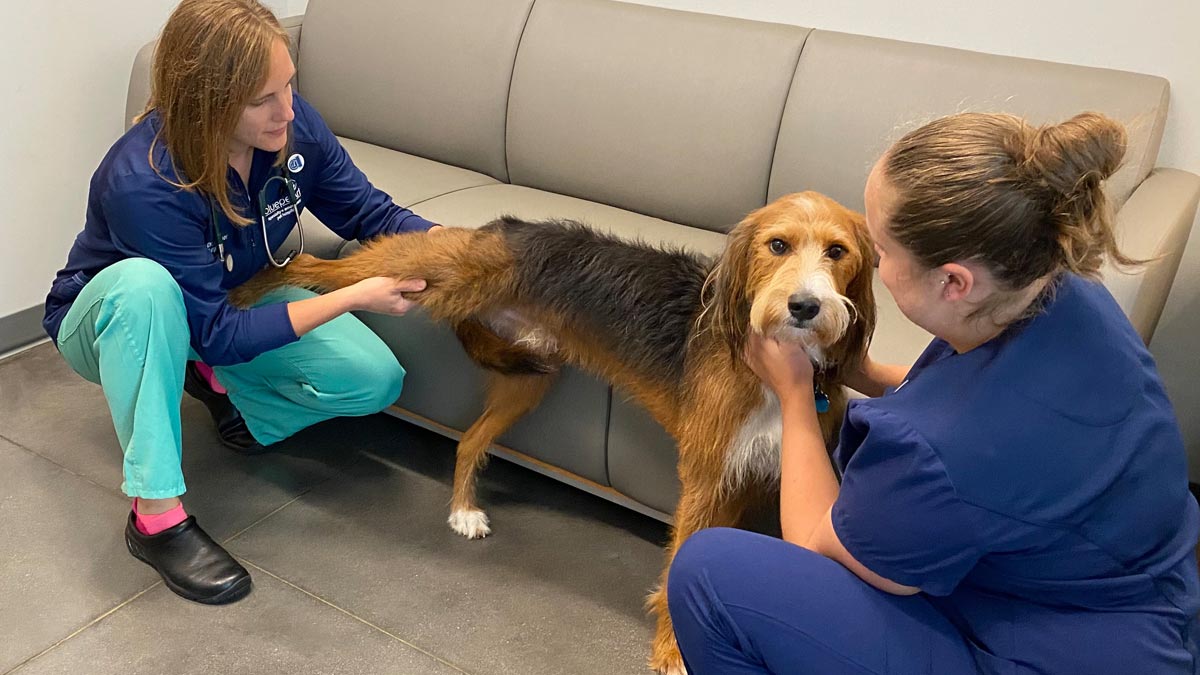What are loving pet parents to do when their new puppy or their long-time pet companion starts to “walk funny.” He or she may slow down a bit, perhaps limping or favoring one hind leg. Some dogs adopt a bunny-hopping motion where they attempt to run with both legs operating in tandem. Your suspicion would certainly be that there’s something amiss with your pet’s legs. And the answer is to make an appointment and let your trusted veterinary doctor take a look.
One such trusted veterinarian is Valerie Nesser, DVM, DACVS, a board- certified veterinary surgeon who practices at the Veterinary Specialty Care hospitals in Mount Pleasant and Summerville. According to Dr. Nesser, the diagnosis may well be hip dysplasia, which she terms “one of the most common orthopedic conditions we see in dogs.”
According to Dr. Nesser, “Hip dysplasia is an inherited disorder that requires lifelong management. It is a complex disease in that there are multiple genes involved, as well as different environmental factors that influence the expression of this disease.”
“Hip dysplasia is most common in large and giant breed dogs,” Dr. Nesser said, noting that these breeds include such popular dog companions as German shepherds, Labradors, golden retrievers, Saint Bernards, Newfoundlands and Great Danes. It occurs rarely in some cats as well.
Dr. Nesser said hip dysplasia can first be noticed in puppies who are only a few months old, who are likely to present with the “bunny-hopping” gait. Older dogs have a wide range of symptoms that generally occur when they begin to develop osteoarthritis. They may balk at walking up and down stairs or become less active during their daily walks.
The primary issue for dogs with hip dysplasia is joint laxity, where the head of the large femur bone and the socket on the pelvis bone do not fit together properly.
“It’s like two puzzle pieces that don’t quite fit,” Dr. Nesser observed, “with the space between the ball and the socket being larger than normal.”
At VSC, she noted, the first line of attack on canine hip dysplasia is medical management. Dr. Nesser prescribes NSAIDs – nonsteroidal anti-inflammatory drugs – to reduce pain and improve limb function. Lifestyle changes such as activity modification, diet for weight loss and the addition of supplements such as glucosamine chondroitin and omega-3 fish oil may be recommended. Pain medications are utilized at the minimum level that will make the dog comfortable.
In some cases, physical therapy may help. Like humans, dogs are placed in a closed therapeutic bath with an underwater treadmill to promote muscle strength and hip range of motion, while limiting impact on uncomfortable hip joints. TENS – transcutaneous electrical nerve stimulation – and thigh muscle massage may also be prescribed.
“We don’t always reach for surgery as a first-line treatment,” Dr. Nesser said. “Surgical interventions are usually considered to be salvage procedures if we have exhausted medical management, and hip pain is still impacting the dog’s quality of life.”
VSC does not currently perform hip replacements on dogs: “We might offer them in the future, but at present we refer these patients to university veterinary surgical departments.”
Dr. Nesser is well-versed in the procedure.
“There are other specialized procedures for puppies,” she noted. “We don’t have the chance to do them often because there’s a very narrow time period during which these surgeries would be beneficial.”
In adult dogs, she pointed out, there are two common surgical interventions. The first is FHO – or femoral head ostectomy. This is removing the head of the femur, thus eliminating painful bone-on-bone contact and allowing a “false joint” to develop through scar tissue formation. The gluteal and other hip muscles will help hold the bones in place while scar tissue forms to help the dog walk. Total hip replacement for dogs, much as in humans, involves replacing both the head of the femur – the ball – and the hip socket with a metal and polyethylene prosthesis.
While the goal of such surgery is to restore the dog to normal mobility, it can be expensive for the owner, requires physical rehabilitation for the dog and opens the door to potential complications, including implant infection and, in some cases, a fracture of the femur itself.
So, if your puppy is “bunny-hopping” or your older dog is showing a serious limp or other change in gait, see your vet. There are a variety of treatments ranging from medical management to total hip replacement that will improve your furry friend’s mobility.







